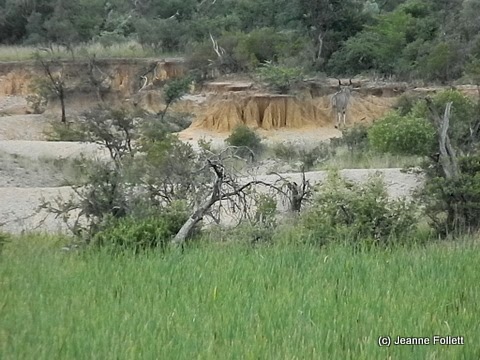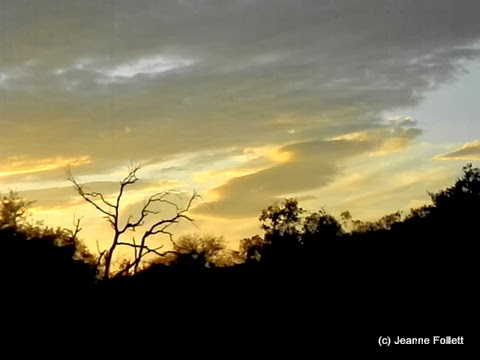The Africa Journals
Chapter 20
In The Company of Elephants
If elephants didn't exist, you couldn't
invent one. They belong to a small group of living things so unlikely they challenge
credulity and common sense. - Lyall Watson
Dawn brushes the African sky with a palette of golden hues as we venture into the bushveld of Mabula Reserve. A hard rain during the night washed away the old spoor of animals and left a clean canvas for the guides to interpret.
There’s wistfulness this morning as it is our last safari at Mabula. Later this morning, our suitcases will be
placed outside our doors for the porters to fetch and our coach will take us
south to Johannesburg. There, six others
who did not opt for this pre-extension, will join us for the basic trip.
The safari vehicle radios
are active this early morn as the guides report to each other what they’re
seeing.
We pass leopard and hyena
tracks, and come upon fresh elephant dung on the roads. Francis stops at a pile of dung and inserts a
finger into it as if testing it for warmth.
Then he puts his finger in his mouth.
He turns to us with a expectant face.
We’d been clued in by Brian. Francis used his middle finger to touch the dung, but his index finger is the one that went into his mouth. Nonetheless, Francis enjoys the prank as much as we do. And i didn't have the camera ready.
 |
| leopard tracks |
Reports of the elephants moving in a certain direction come over the radio. Downed trees block our way on a back trail, usually certain signs that elephants have been here, but these trees could also be windfall from last night’s storm.
The guides are working hard to find the herd, but our hopes are dimmed by the knowledge that the morning is cool and the beasts tend to group up in thick trees for warmth.
 |
| The guides inspecting tracks. |
We pass herds of impala, eland, gnu, and solitary warthogs. We spook a warthog that had spent the night in a hole excavated by an aardvark. Backwards. They move in backwards, their heads and those vicious tusks ready for defense.
Warthogs are able to dig their own burrows but they much prefer the ready-made ones.
 |
| This male Nyala never would lift up its head. Its appearance differs greatly from the females. |
On we go, with Francis and Brian (and everyone in the safari vehicle) watching for tracks and signs of a herd of large pachyderms on the move. There are lots of tracks.
 |
| Impala |
We spot a secretary bird in
the grass, so named because its upper white feathers resemble a
clerk’s morning coat, and the feather spikes that evoke quill pens stuck in a
clerk’s hair or behind the ear. As tall
as four feet, secretary birds are deadly snake hunters and use their long legs
and talons to stomp the reptiles to death.
 |
| Quite a way off in a field, so the photo is blurry. |
Their legs are long like a stork’s, and are feathered halfway down, then protected from snakebites by thick scales. Their heads resemble a hawk’s and they are classified as a bird of prey.
 |
| The secretary bird's legs are again as long as the part covered with black feathers. That part of the leg is bare but protected with thick snake-bite-proof scales. |
Again, I am struck by my lack
of size perspective. In the tall grass,
the secretary birds appears to be goose-sized, not three or four feet tall. A video, played so the observer could count
the number and accuracy of a secretary bird stomping a snake, revealed that the
bird was remarkably accurate, always hitting the snake in the head, according
to Brian, who tells corny jokes, but rarely exaggerates animal information. Except about the warthog, but I’ll save that
for another day.
Our drive takes us to an area called “The erosion.” It is bleakly beautiful.
 | ||||
| Note the well-disguised male Kudu near the upper right. |
We circle around again, and suddenly…
What a spectacular sight, these huge animals in natural surroundings, their incredibly dexterous trucks ripping clumps of grass from the ground or branches from trees.
Their slow and fluid movements are mesmerizing and I can well imagine staying here all day, watching their adagio dance.
A large elephant approaches from the right, crosses in front of us, and walks behind bushes, now almost totally camouflaged.
Another safari vehicle arrives for a view of these enormous animals, and we cede the way. It’s time to return to Mabula Game Lodge for breakfast and last-minute packing. At 11 A.M., we will board the coach and drive to Johannesburg.
I am conflicted about leaving.
I know we have Chobe National Park in Botswana and Kruger National Park in South Africa to visit, but those are vast areas and Chobe is unfenced. What are our chances of seeing wild animals there as opposed to in this relatively small reserve of 43 square miles?






















YES WOW! The entire web site is ONE HUGE WOW .. top to bottom .. 2008 to present! I can only imagine how pleased you are to have taken (as opposed to six others who did NOT opting for the basic trip only) what you call .. The Pre-Extension ! And again .. how on earth can the tiny little rodent called a Rock Hyrax or Dassie BE CLOSELY RELATED to the elephant? Finger in-the-dung and Finger in-the-mouth .. too funny. I wonder if some visitors choose to only visit Mabula Game Lodge the (your words) small 43 square-mile preserve. With Joy .. Cap and Patti ..
ReplyDeleteI can understand your conflicted feelings. It's hard to leave an area where your wildest dreams have come true.
ReplyDeleteyou haven't seen anything yet!
Delete